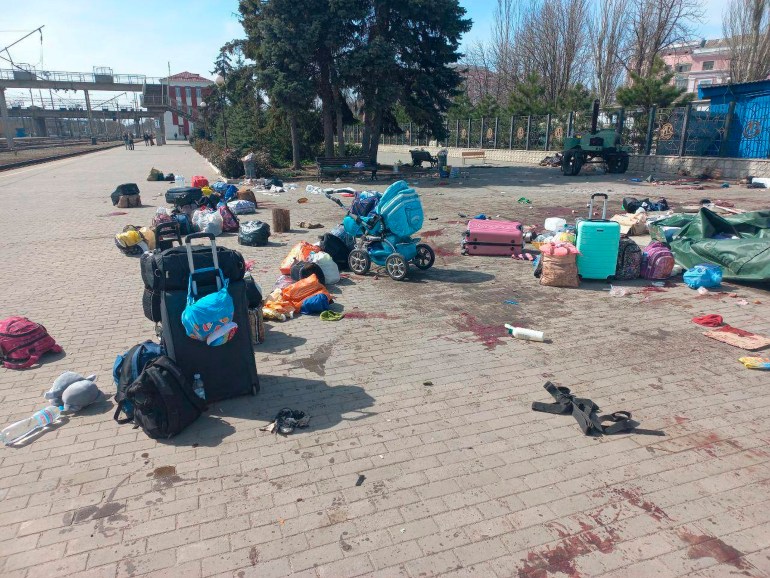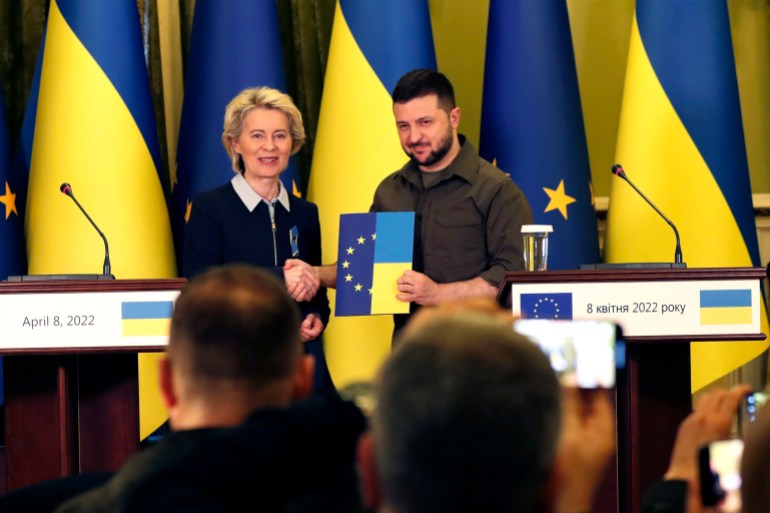Ukraine braces for new Russian assault in the east | Russia-Ukraine war News
Ukraine has spent much of the seventh week of the war asking for more weapons donations, as it prepares for a renewed Russian offensive in the east of the country.
Russian forces took control of the city of Izium on April 6, and bisected Ukrainian defences in the port city of Mariupol, reaching the Sea of Azov on April 10. Between these two locations, Russia was building up its forces in a crab’s claw around the cities of Kramatorsk and Sloviansk, in what Ukraine expects will be an attempt to join its northern and southern fronts in a pincer movement to isolate Ukrainian elite units in the Donetsk and Luhansk provinces in eastern Ukraine.
Luhansk governor Serhiy Gaidai posted a message on April 6 saying, “I appeal to every resident of the Luhansk region – evacuate while it is safe. While there are buses and trains, take this opportunity.”

The following day, Russia was accused of firing a missile at the Kramatorsk train station as thousands of civilians waited to evacuate the city. At least 52 people were killed.
“If at the beginning they exclusively … targeted railway tracks, then now it’s not only tracks, but also firing a missile containing cluster munitions which are meant for people,” said regional governor Pavlo Kyrylenko. He said the missile fired was a Tochka U, which explodes midair spreading bomblets over a wide area.
The spent missile casing has had the words “for children” written on it in Russian. Russia’s defence ministry said it does not use Tochka U missiles and had assigned no targets in Kramatorsk on the day of the attack.
In an exclusive interview with Al Jazeera, Ukrainian President Volodymyr Zelenskyy said he believed Russia has targeted civilians in the war.
“Usually, whenever any political leader of Russia is saying that they are not shooting at civilians … I think that at that moment, the population should be preparing themselves,” he said.

A war of attrition
Battles escalated in the east during the week, with Ukraine saying on April 8 it had destroyed nine tanks, seven armoured vehicles and two helicopters. Russia targeted Ukrainian air defences and aircraft, claiming it had destroyed two SU-25 fighter jets, a MiG-29 jet, a helicopter and four S-300 anti-air missile batteries throughout the week. It also destroyed the airport in the central Ukrainian city Dnipro.
“Ukraine has suffered significant attrition over the course of the war in terms of both fighter aircraft, usable airbases and – crucially – long-, medium- and short-ranged surface-to-air missile (SAM) systems,” said Justin Bronk, senior research fellow for airpower and technology at the Royal United Services Institute.
“As a result of these losses, although the airspace over most of Ukraine is still very dangerous for Russian aircraft, the front-line areas in the east and the south, which are close to Russian controlled airspace anyway, have seen increased Russian use of airpower against battlefield targets in recent weeks,” Bronk told Al Jazeera.
“Nevertheless, the Russian air force still struggles to achieve particularly accurate results against battlefield targets en masse due to the limited numbers of precision-guided munitions which its fast jet and helicopters can use. They can achieve accuracy with unguided bombs and rockets only by attacking down to low level where MANPADS and ground fire pose a significant threat.”
Bronk said resupply efforts by Western nations to provide Ukraine with new mobile SAM systems that they can use immediately, such as S-300 long-range and SA-8 short-range SAMs, would be crucial to maintaining the risk to Russian medium-altitude sorties deeper into Ukraine, as would the resupply of surface-to-surface munitions.
“The deciding factors [in the battle for the east] will be whether Ukraine receives sufficient supplies of ammunition – especially artillery and anti-tank ammunition – to repel the Russian offensive in Donbas, and whether the depleted Russian units withdrawn from the northern axes can provide sufficient usable combat power in Donbas to generate a decisive local Russian advantage in the face of Ukrainian reinforcements,” he told Al Jazeera.
Zelenskyy asked national parliaments in Ireland, Greece and South Korea to approve weapons donations. In his interview with Al Jazeera, he said Russian President Vladimir Putin has not given up on his original plan to take all of Ukraine, despite the withdrawal of Russian forces from around Kyiv, Chernihiv and Sumy in the north. “If our forces in Donbas won’t be able to hold their positions, then the risk of a repeated offensive against Kyiv is probable,” he said.
NATO foreign ministers meeting on April 7 agreed to step up immediate supplies of weapons to Ukraine.
“There was support for countries to supply new and heavier equipment to Ukraine so that they can respond to these new threats from Russia. We’ve agreed to help Ukrainian forces move from their Soviet-era equipment to NATO-standard equipment on a bilateral basis,” said British Foreign Secretary Liz Truss.
Alleged atrocities bring further sanctions
A string of dignitaries paraded through Kyiv during the week after Ukrainian officials alleged that Russian forces carried out mass killings of civilians when they occupied areas around Kyiv. European Commission President Ursula Von Der Leyen on April 8 called the killings “unthinkable”.
She handed Ukrainian president Volodymyr Zelenskyy a questionnaire that starts off Ukraine’s process of joining the European Union. “It will not as usual be a matter of years to form this opinion, but I think a matter of weeks,” she said. Ukraine applied to join the EU on February 28, four days after a full-scale Russian invasion.

Austrian Chancellor Karl Nehammer also stopped over in Kyiv on his way to meet Putin in Moscow, in an attempt to bring hostilities to an end. He declared he had “no optimistic news” after the meeting.
British Prime Minister Boris Johnson also met Zelenskyy in Kyiv.
“What Putin has done in places like Bucha and Irpin is war crimes that have permanently polluted his reputation and the reputation of his government,” Johnson said, referring to places where teams of experts are gathering evidence of alleged atrocities carried out by Russian forces against civilians.
Western countries reacted to the alleged atrocities by imposing more punitive sanctions on Russia and the UN General Assembly voted to suspend Russia from the organisation’s Human Rights Council, the world’s top human rights body.
As a permanent Security Council member, Russia has managed to block two resolutions reprimanding it for its invasion of Ukraine, but it has been condemned in three separate three votes at the General Assembly.
US President Joe Biden issued an executive order on April 6 prohibiting US persons from investing in Russia, financing activities there by third country nationals or exporting services to Russia.
Two days later the European Union banned Russian coal imports, worth eight billion euros ($8.7bn) a year, as well as other Russian imports. It barred Russian ships from entering EU ports, and Russian-registered trucks from EU roads.
The EU’s Freeze and Seize task force, formed to coordinate the implementation of Russian sanctions among member states, says 29.5 billion euros worth ($32bn) of Russian assets have been seized so far, and 196 billion euros worth ($212bn) of transactions blocked.
NATO expansion?
Sweden and Finland appeared to be moving closer to NATO membership as a result of the war in Ukraine. The leaders of both countries have said a decision on joining the transatlantic military alliance could come by the end of June. Opinion polls suggested that pro-NATO sentiment has doubled in both countries since Russia invaded its neighbour.
“I expect that all allies will welcome them,” NATO Secretary-General Jens Stoltenberg said. “We know that they can easily join this alliance if they decide to apply.”
A March poll for Finnish broadcaster YLE showed that more than half of Finns would support the move for the first time in the country’s history. Russia has warned both countries against NATO membership.

Pingback: sig mcx spear
Pingback: terras parasol kopen
Pingback: 토렌트
Pingback: where to buy psilocybin capsules
Pingback: Continue Reading
Pingback: instant crypto exchange
Pingback: link
Pingback: 7 slots
Pingback: เว็บตรง สล็อต บาคาร่า
Pingback: Polkadot mushroom for sale usa
Pingback: Plinko casino Polska aplikacija